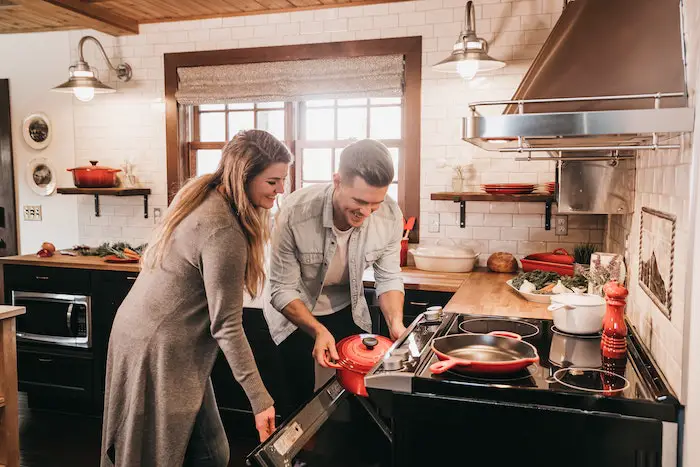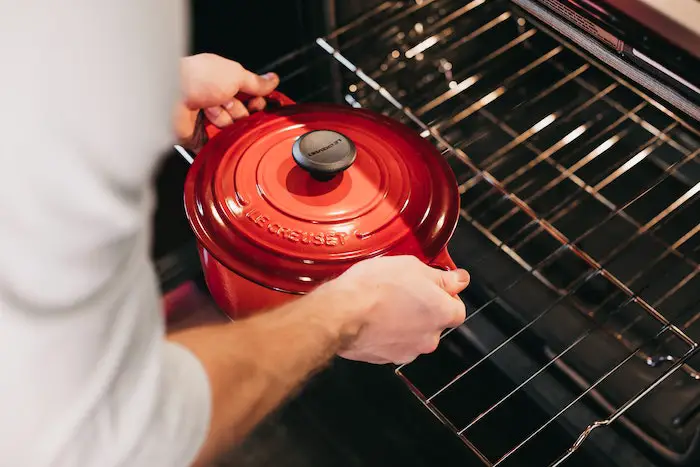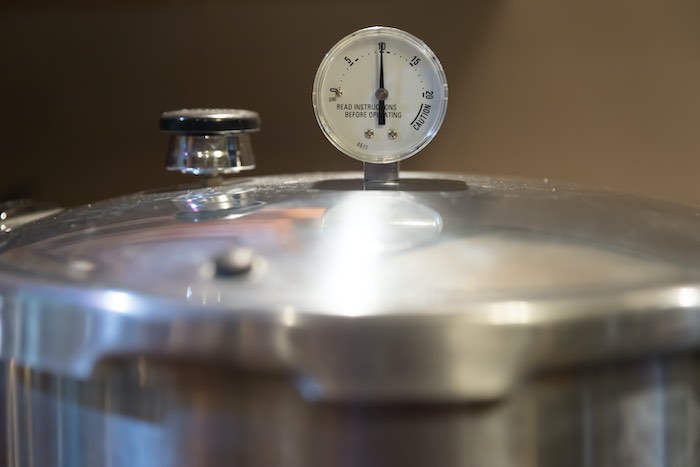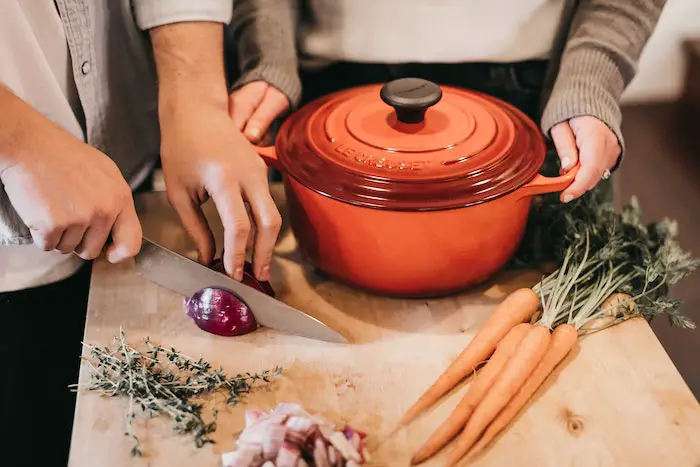Enameled cast iron is heavy, thick-walled cookware with a porcelain enamel coating on the inside and the outside. It is significantly more expensive than other types of culinary equipment, such as stainless-steel pots and pans.
That said, when you own enamel cookware, you may want to know how best to care for it, which brings us to the question that begs to be answered: can you put enameled cast iron cookware in the oven?
Enameled cast iron cookware is safe to use in the oven (up to 500 degrees Fahrenheit) and on all stovetops. However, you should note that these units get extremely hot while cooking, so exercise caution when using them if you have children or pets. You also should not leave the unit unattended because it is capable of causing fires if left alone for too long.
This article will talk about enamel cast iron kitchenware, using and taking care of it, and other related questions.
Types of Enamel Cast Iron Cookware
There are different kinds of enameled cast iron pieces you can buy from kitchen supply stores. They include:
Cookware sets, which include smaller saucepans and skillets for cooking breakfast items such as omelets, and hash browns
- Dutch ovens
- Roasters
- Stockpots
- Casserole dishes
- Frying pans
- Stew pots
You can use these pieces when you want to prepare various dishes that range from rice pilaf, beef stroganoff, pasta marinara, beef stew, scalloped potatoes, or roasted chicken.
Putting Enamel Cast Iron in the Oven
You can put enameled cast iron in the oven for cooking recipes where you need two separate pieces of cookware (e.g., searing meat then transferring it to an oven-safe pot or pan). Enameled cast iron can be used in the oven so long as you transfer the food to another vessel before putting it in.
This material is particularly popular among people who enjoy making stews because it makes it very easy to do so, given the even distribution of heat.
Differences between Enamel Cast Iron and Regular Cast Iron
Enamel cast iron is far more expensive than other types of cookware, but its durability makes up for this added cost because you will only have to buy one piece once every few decades.
It is also much heavier than other forms of cookware, but that extra weight helps distribute heat more evenly while cooking. Regular cast iron skillets are mostly made of thin metal with a porous surface that rusts and stains easily.
Since it’s thinner, regular cast iron distributes heat poorly, resulting in food burning easily. However, enameled cast iron heats up faster than traditional pans because the material is thicker, which means you will not have to wait as long for your food to cook.
Benefits of Enamel Cast Iron
- You can use it in the oven so long as you transfer the food to another vessel
- It distributes heat evenly when cooking, reducing the likelihood of food burning. Regular cast iron cookware does not distribute heat well, so it is more likely for your food to burn when using this material.
- Lighter weight that helps prevent wrist and arm fatigue
- Heats up faster than regular cast iron skillets
- Comes with a very smooth gloss finish that makes it easier to clean
- Stain-resistant surface prevents rust from forming on the pan after washing it. Regular cast iron has a porous surface, making it easier for rust to form on the metal if improperly dried or cleaned. This will make your cookware look dull and rusty.
- Comes with a lifetime warranty
- You can use it to cook acidic foods such as tomato dishes or seafood because the enameled cast iron is resistant to corrosion. In addition, it does not react with food, so you will not have to worry about metallic-tasting meals.
Proper Use, Storage, and Maintenance of Enamel Cast Iron Cookware

- When cooking with enamel cast iron, you should always preheat the pan before adding the oil. After the pan has heated up, add a little oil and wait until it simmers before cooking your food.
- You should never use metal utensils on these types of pans because they can scratch or chip off pieces of the coating that could then contaminate your food. You also should not put them in the dishwasher or let them soak for extended periods because this increases the chances that their protective layer might peel away from prolonged exposure to water.
- If you want to maintain an enamel cast iron piece, make sure you clean away excess grease after every use by using paper towels or a cloth. After cleaning it, place the items in a cool and dry place.
- To prevent rusting, you can coat your cookware with cooking oil before storing it away. If the cookware’s enamel coating gets chipped or cracked, remove any loose pieces by hand and then rub some olive oil into the unit to form a protective layer that prevents water from seeping inside.
- Enamel cast iron is safe for steaming potatoes and root vegetables such as beets and carrots, but you should not use it when boiling foods because it causes the liquid to dissolve the enamel. You also should not line these types of pans with aluminum foil because doing so can cause metal ions from both substances to leech into your food, which could make you sick.
Related Questions
Are enamel cast iron pots safe to use?
Enamel cast iron is safe to cook with as long as you follow the instructions for using it safely in the oven, on the stovetop, or in broilers.
However, it’s best used in dry cooking methods like baking, roasting, sautéing, pan-frying, etc. If you try to boil liquids in an enameled cast iron pot, the acidic nature of the ingredients will damage its protective coating over time.
This can cause it to chip or crack prematurely, which creates rust-attracting crevices that could compromise its structural integrity.
Regular cast iron skillets are okay to use in both dry and liquid cooking methods because they only have a protective fat coating that needs to be refreshed every so often.
What can you cook in enamel cast iron?
You can use these types of pots for soups, stews, and chili because the pans distribute heat evenly, so your meal cooks without burning or scorching. You should not put these types of skillets in the dishwasher or leave them wet after washing up because this increases your chances of rust forming on the surface.
What are the safest ways to cook with enamel cast iron?
Enameled cast iron pots are best suited for foods that require longer cooking times, such as stews, soups, beans, braised meats & poultry, roasted vegetables, chili, casseroles, etc.
These pans are great when making dishes with wine because the liquid does not remove its protective coating when simmering on low heat. Additionally, they are suitable for baking bread and cakes because their exteriors evenly distribute radiant heat. You can use them to make homemade pizzas, too.
See Alos:
Can You Put Plates In The Oven?
8 Best Cookware For Indian Cooking In USA
How To Clean Outside Of Pots And Pans?
7 Best Lunch Coolers For Construction Workers


